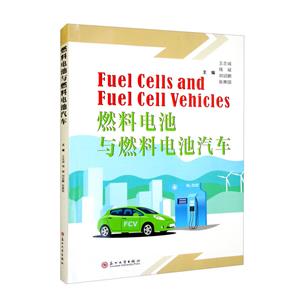-
>
湖南省志(1978-2002)?铁路志
-
>
公路车宝典(ZINN的公路车维修与保养秘籍)
-
>
晶体管电路设计(下)
-
>
无头案:雍正暴亡之谜
-
>
基于个性化设计策略的智能交通系统关键技术
-
>
花样百出:贵州少数民族图案填色
-
>
识木:全球220种木材图鉴
燃料电池与燃料电池汽车 版权信息
- ISBN:9787567238886
- 条形码:9787567238886 ; 978-7-5672-3888-6
- 装帧:一般胶版纸
- 册数:暂无
- 重量:暂无
- 所属分类:>
燃料电池与燃料电池汽车 内容简介
Fuel cell(FC)is an effective and environmentally friendly electrochemical power generation device, which can directly convert the chemical energy of fuel and oxidant into electric energy. Nowadays, with the increasingly serious problems of environmental pollution and energy shortage, the research & development(R&D)and application of FC technology have attracted more and more attention from governments and researchers worldwide, Compared with other types of new energy vehicles, fuel cell vehicles(FCVs)have apparent advantages. Hence, with the development of research & development and engineering of the hydrogen preparation, storage, transportation, and application of hydrogen and the breakthroughs in FC retaled technologies, FCVs will have a more important position and broad prospects in developing new energy vehicles in the future. With the gradual practicality and marketization of FCVs, there will be more and more demand for personnel engaged in the design and manufacture, operation and maintenance, sales and promotion of FCVs. Therefore, it is urgent to cultivate engineering and technical talents to adapt to the fast growth of industry. The book is written under this background. The book consists of 5 chapters. Chapter 1 is compiled by Wang Zhicheng, which mainly introduces the working principle, classification, development history, characteristics, and application of FCs. Chapter 2 is compiled by Qian Bin to mainly present the electrochemical basis, polarization and the test method for polarization of FCs. Chapter 3 is compiled by Wang Zhicheng and Liu Guanpeng, which mainly introduces six FC types and emphasizes proton exchange membrane fuel cell(PEMFC), solid oxide fuel cell(SOFC)and alkaline fuel cell(AFC). Chapter 4 is compiled by Wang Zhicheng to mainly introduce the preparation, purification and storage of hydrogen for FC. Chapter 5 is compiled by Zhang Huiguo and Wang Zhicheng to mainly present the knowledge and the infrastructure facilities relating to FCVs. Wang Zhicheng is in charge of the final compilation and editing of the whole book.
燃料电池与燃料电池汽车 目录
1.1 Working Principle of Fuel Cell
1.2 Classification of Fuel Cell
1.3 Development History of Fuel Cell
1.4 Characteristics of Fuel Cell
1.5 Application of Fuel Cell
References
Chapter 2 Electrochemical Basis of Fuel Cell
2.1 Fuel Cell Thermodynamics
2.1.1 Relationship Between Gibbs Free Energy and Electromotive Force of Cell
2.1.2 Nernst Equation
2.1.3 FC Efficiency
2.2 Kinetics of Electrode Process
2.2.1 Faraday's Law and Electrochemical Process Rate
2.2.2 Electrochemical Reaction Rate
2.3 Polarization
2.3.1 Electrochemical Polarization
2.3.2 Concentration Polarization
2.3.3 Ohmic Polarization
2.4 Polarization Test
References
Chapter 3 Fuel Cell Type
3.1 Proton Exchange Membrane Fuel Cell
3.1.1 Structure and Working Principle of PEMFC
3.1.2 Development History of PEMFC
3.1.3 Main Components of PEMFC
3.1.4 Single Cell and Cell Stack of PEMFC
3.1.5 Analysis of PEMFC Stack Failure
3.2 Direct Methanol Fuel Cell
3.2.1 Structure and Working Principle of DMFC
3.2.2 Key Materials of DMFC
3.2.3 Differences Between DMFC and PEMFC
3.2.4 Existing Problems of DMFC
3.2.5 Application of DMFC
3.3 Solid Oxide Fuel Cell
3.3.1 Structure and Working Principle of SOFC
3.3.2 Development Overview of SOFC
3.3.3 Key Materials of SOFC
3.3.4 Development Trend of SOFC
3.3.5 Problems of SOFC
3.3.6 SOFC Stack
3.3.7 High Power Density SOFC
3.4 Alkaline Fuel Cell
3.4.1 Structure and Working Principle of AFC
3.4.2 Development Overview of AFC
3.4.3 Key Materials of AFC
3.4.4 Drainage of AFC
3.4.5 Advantages and Disadvantages of AFC
3.4.6 Single Cell and Cell Stack of AFC
3.5 Phosphoric Acid Fuel Cell
3.5.1 Structure and Working Principle of PAFC
3.5.2 Development Overview of PAFC
3.5.3 PAFC Materials
3.5.4 PAFC Stack
3.5.5 Factors Affecting PAFC
3.5.6 Factors Affecting Lifetime and Improvement Methods
3.5.7 Advantages and Disadvantages of PAFC
3.6 Molten Carbonate Fuel Cell
3.6.1 Structure and Working Principle of MCFC
3.6.2 Development Overview of MCFC
3.6.3 Key Materials of MCFC
……
Chapter 4 Preparation, Purification and Storage of Hydrogen Fuel for Fuel Cells
Chapter 5 Fuel Cell Vehicle
Acronyms
- >
史学评论
史学评论
¥13.9¥42.0 - >
烟与镜
烟与镜
¥20.6¥48.0 - >
企鹅口袋书系列·伟大的思想20:论自然选择(英汉双语)
企鹅口袋书系列·伟大的思想20:论自然选择(英汉双语)
¥6.3¥14.0 - >
伯纳黛特,你要去哪(2021新版)
伯纳黛特,你要去哪(2021新版)
¥15.9¥49.8 - >
自卑与超越
自卑与超越
¥13.5¥39.8 - >
山海经
山海经
¥20.4¥68.0 - >
伊索寓言-世界文学名著典藏-全译本
伊索寓言-世界文学名著典藏-全译本
¥6.1¥19.0 - >
有舍有得是人生
有舍有得是人生
¥31.5¥45.0
-
桥梁史话
¥15.9¥37 -
世界桥梁趣谈
¥10.6¥28 -
新能源汽车结构与原理-全彩图解
¥61.6¥88 -
船舶电站组建与调试
¥29.3¥45 -
城市轨道交通供电工程
¥22.3¥29 -
汽车技术精品著作系列新能源汽车设计基础
¥70.1¥89.9
















